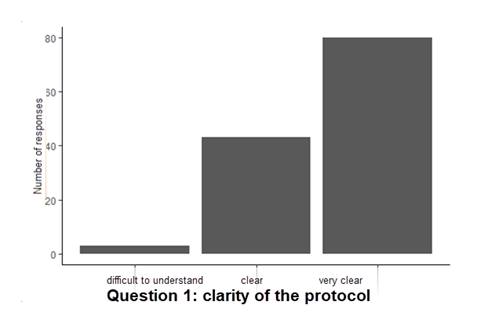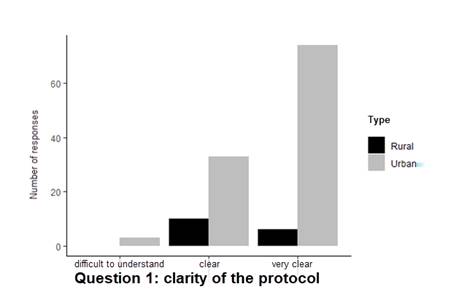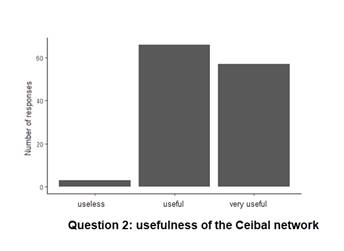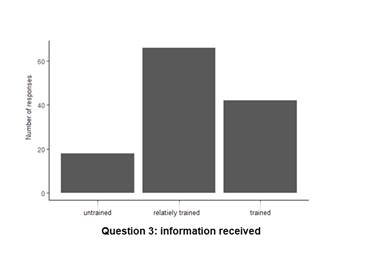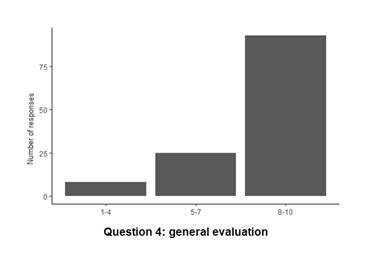Servicios Personalizados
Revista
Articulo
Links relacionados
Compartir
Odontoestomatología
versión impresa ISSN 0797-0374versión On-line ISSN 1688-9339
Odontoestomatología vol.23 no.37 Montevideo 2021 Epub 18-Mayo-2021
https://doi.org/10.22592/ode2021n37a4
Research
Oral health promotion tool for teachers on dealing with traumatic dental injuries in schoolchildren through the Ceibal network
1Cátedra de Odontopediatría, Facultad de Odontología, Universidad de la República, Uruguay
2Ex Directora de Carreras de Especialización y Maestría en Odontopediatría. Facultad de Odontología. Universidad de la República, Uruguay
3Departamento de Educación. Facultad de Medicina. Universidad de la República, Uruguay
4Grupo de Investigación PROCON, Universidad Nacional de Córdoba, Argentina
Dental trauma affects mainly children, and when they are at school; immediate action improves its prognosis.
Objective:
To evaluate the implementation of a virtual tool describing the immediate actions to take when children sustain traumatic dental injuries. The tool was included in the nationwide ICT network called Educational Connectivity in Basic Computing for Online Learning (Ceibal network).
Methodology:
A multi-method action-research design was developed. The qualitative analysis was conducted applying descriptive statistics and the quantitative analysis, grounded theory.
Results:
A total of 138 responses were received: 92% women, 51% from Montevideo schools, and 13% from rural schools. Four categories were identified in how the situation was addressed. No significant differences were found in people’s opinion of the virtual protocol (web application) when comparing the type of school or location. Regarding satisfaction with the training received, 75% rated it ≥8 (scale 1-10).
Conclusions:
Including ICT in activities that promote oral health was positively valued by stakeholders.
Keywords: Information and Communication Technologies (ICT); health promotion; dental trauma; Ceibal network
Los traumatismos dentarios se producen principalmente en la edad y ámbito escolar; el accionar inmediato mejora su pronóstico.
Objetivo:
Evaluar la implementación de una herramienta virtual que describa las acciones inmediatas a ejecutar ante lesiones traumáticas dentarias en niños a través del Plan de Conectividad Educativa de Informática Básica para el Aprendizaje en Línea, red informática de alcance nacional.
Metodología:
Se desarrolló un diseño de investigación-acción, multi método. Para el análisis cuantitativo se aplicó estadística descriptiva y teoría fundamentada para el cualitativo.
Resultados:
Se recepcionaron 138 respuestas, 92% mujeres, 51% escuelas de Montevideo, 13% rurales. Se diferenciaron 4 categorías en la resolución de la situación. La percepción sobre claridad del protocolo no mostró diferencias significativas según tipo de escuela ni localización. El 75% valoró con ≥8 (escala 1-10) su satisfacción con la capacitación recibida.
Conclusiones
La incorporación de
las TIC en actividades de promoción de salud bucal fue valorada positivamente desde los propios actores.
Palabras clave: Tecnologías de la Información y la Comunicación (TIC); Promoción de salud; Traumatismos dentarios; Red Ceibal
Os traumatismos dentários se produzem principalmente na idade e âmbito da escola; uma açao imediata melhorará seu prognóstico.
Objetivo:
Avalie sua implementação uma ferramenta virtual que descreva as ações imediatas a serem tomadas diante de lesões traumáticas em crianças por meio do Plano Básico de Conectividade Educacional de Computação para Aprendizagem Online, uma rede nacional de computadores.
Metodologia:
Foi desenvolvido um projeto de pesquisa-ação multi-método. Para a análise quantitativa, foram aplicadas estatísticas descritivas, e teoria fundamentada. para o a qualitativao.
Resultados:
Foram recebidas 138 respostas, 92% mulheres, 51% escolas de Montevidéu, 13% rurais. 4 categorias foram diferenciadas na resolução da situação. A percepção de clareza do protocolo não apresentou diferenças significativas conforme o tipo de escola ou localidade. 75% avaliaram sua satisfação com o treinamento recebido como ≥8 (escala de 1 a 10).
Conclusões:
A incorporação das TIC nas atividades de promoção da saúde bucal foi valorizada positivamente pelos próprios atores.
Palavras-chave: Tecnologias da Informação e Comunicação (TIC); Promoção da Saúde; Trauma Dental; Rede Ceibal
Introduction
A high percentage of traumatic dental injuries occur in children and when they are at school. Having the necessary knowledge to act immediately significantly improves the health prognosis of traumatized teeth 1). The Department of Pediatric Dentistry of the School of Dentistry, Universidad de la República (UdelaR) implements various activities for children and adolescents in oral health education, promotion, and prevention through different communication channels. Innovation in education is a change process that aims to validate and transform education to improve the living conditions of individuals and their communities. The 21st century has been labeled as the information age or society 2 because people are immersed in an information environment or ecosystem 3 that floods everyday life, among other reasons. Information is essential in new societies, and digital technologies are used for developing, disseminating, and accessing this information. We live in two scenarios simultaneously: the material, physical and sensory reality, and the virtual experiences provided by multiple digital devices (Internet, mobile telephony, video games, networks, tablets, digital TV, etc.). Therefore, digital culture is a crucial socialization scenario for 21st-century individuals and requires citizens to be trained throughout life due to its constant transformation in content and form. The International Dental Federation (IDF, Vision 2020) 4 states that “ICT is spreading quickly on a global scale,” and therefore, “E-Health” is rapidly becoming a reality. E-health makes it possible to strengthen the collaboration among professionals, help disseminate health promotion and disease prevention messages electronically, and promote universal access to vocational training through virtual learning tools.
Uruguay has a nationwide ICT network called Educational Connectivity in Basic Computing for Online Learning (Ceibal network) 5. It is a socio-educational project created through Executive Decree No. 144/007 of 18/Apr/2007. It aims to conduct studies, provide a laptop computer to every school and public-school teacher, train teachers to use this tool, and promote innovative educational projects.
Innovation in education is a change process that aims to validate and transform education to improve the living conditions of individuals and their communities. Progress has been made in the training of teaching and non-teaching staff in study centers. However, this oral health training remains insufficient and can be improved, and ICT tools have proven to be valid for this purpose. The evolution of the educational model does not simply entail new resources in the classroom but also requires changes in teaching beliefs and practices. Following Adell and Castañeda 6, the new professional competencies involve selecting and reusing digital resources, creating and managing online teaching environments and materials, curating and evaluating learning on an ongoing basis, and implementing professional collaboration and exchange with other teachers in the network. Valverde-Berrocoso 7) states that in addition to these competencies, new teaching professionalism also implies accepting paradigmatic changes in beliefs, methodologies, and practices to shape emerging pedagogies and rethink initial teacher training in the field of educational technology.
This work aims to evaluate the implementation of a virtual tool describing the immediate actions to take when children sustain traumatic dental injuries. The tool was included in the nationwide IT network called Educational Connectivity in Basic Computing for Online Learning (Ceibal network).
Methodology
The methodological design involved a mixed (quantitative-qualitative) strategy-a focused multi-method- which interprets its object of study through a naturalistic approach, considering the teachers’ perspective as the central pillar. Sampieri 8 states that mixed research methods integrate quantitative and qualitative methodologies to obtain a fuller picture of the phenomenon without losing its original structures and procedures or undergoing adaptations or alterations. According to Sampieri's classification, this work is a research-action model from a technological, non-participating perspective within sequential transformative studies. The researcher raises a problem and uses technology to build a tool to solve such a problem (8. Descriptive statistics were applied to analyze quantitative data 9, and grounded theory was used to analyze qualitative data 10).
The study targeted teachers in public schools using the Ceibal network. The participants were teachers who graduated from Uruguayan teacher training institutions (Institutos Normales, de Profesores Artigas-IPA or similar) and worked at public schools when the research was conducted. They gave their consent and answered the survey.
This study complies with Decree 379/008 and Ordinance 2010 (IMPO - Regulations and legal notices of Uruguay) 11, has the institutional support of the School of Dentistry, UdelaR, the authorization of the National Administration of Primary Education (ANEP), and the approval of the Ethics Committee of the School of Dentistry, UdelaR (file No. 198/16). The teachers’ consent was requested, highlighting the freedom to withdraw from the study at any stage. A code system was used for identity protection.
The study was conducted in three phases.
1) Diagnosis of the situation. The Ceibal network newsletter provided teachers with a brief description of the project, the informed consent form, and the research tool including three sections: i) informed consent, ii) demographic information (age, sex, years of teaching experience, type of school (urban, rural), among others, and iii) life story regarding dental trauma in the school environment.
2) Developing and publishing the virtual educational resource that provides guidelines on what to do when a child sustains a traumatic dental injury.
We designed a virtual protocol that describes the immediate actions to take when a child sustains a traumatic dental injury. The protocol was made available to teachers through the Ceibal network. We took the International Association of Dental Traumatology Guidelines (IADT) and modified and adapted them to suit our target population, selecting theoretical content and new visual aids. The language was adapted, and specific charts and drawings were designed. The contents were organized following Watson, Pavlov, and Skinner’s behavioral learning theory 12). The application's presentation was written by the Director of the Uruguay Educa Program, CEIP, ANEP, cited: http://www.dravgv.com/traumadental/.
3) Exploratory study of teachers’ perceptions of the technological resource implemented and degree of satisfaction through a Likert-type four-question survey. Teachers were asked to apply a scale of 1 to 10 to assess the procedure in terms of agreement, functionality, accessibility, content, design, and degree of satisfaction regarding the information received to solve the problem. A fifth open-ended question captured the intensity of respondents’ feelings and emotions.
Results and discussion
A total of 138 teacher responses were received over nine months (from August 2018 to May 2019)
Demographic characteristics of the population under study
Women accounted for 92% of the responses (127), in line with the 2014-2015 nationwide census of the Education Training Council (Consejo de Formación en Educación) 13, which reported that 70% of teachers are women. Of the 138 participating teachers, 68% have been teaching for 20 years or less; 35% for 10 years or less; 33% between 11 and 20 years; 19% between 21 and 33 years; and 13% between 31 and 40 years. López de la Madrid (2013) 14) identified age as a determining factor for teachers and new technologies in a study conducted in Mexico. She reports that 57% of the 22-30 age group stay updated with technology, while 46% of the respondents over 50 do so only when they need to learn a new application. In our study, 70% of respondents have been teaching for 20 years or less. Therefore, we can deduce that this group pays more attention to the innovations uploaded to the Ceibal website and are more motivated to exchange and contribute their visions and knowledge in the platform. Regarding the type of school and location, ICT seems to be the cornerstone that will reverse the traditional isolation rural schools have faced for decades (Morales) (15. Lorenzo and Santos (16 state that rural areas are still not on an equal footing regarding the number of social, cultural, and educational resources and activities. While staffing and acceptability appear to be adequately covered, some areas lack full accessibility, and adaptability remains a pending subject. This study shows a balance regarding the location of the schools where respondents work (51% Montevideo-capital, and 49% outside the capital). However, there is a high percentage (87%) of urban schools among the total number of respondents. These data are relevant because the Ceibal Plan 17) reports that rurality lags in terms of the number of users and connection quality when analyzing the ICT-territory connection. In other words, there is an unfavorable digital divide that isolates deep rural areas and which decreases with greater urbanization. The Ceibal network has provided Internet access and the appropriate equipment to populations isolated in the past. A high percentage of teachers (96%) wished to receive more information on oral health. We agree with Pareskeva and Olivera 18 that it is not enough to saturate classrooms with technology. Instead, we need to effect a profound change in the pillars of the education system. It is essential to understand that other social dynamics are replicated within classrooms and determine new ways of interacting with knowledge; teachers need to know, recognize and participate in these methods to design contextualized teaching situations.
Teachers’ experiences of dental trauma in the school environment
Of the 138 respondents, 74 report experiencing one or more situations where children sustained traumatic injuries to both temporary and/or permanent teeth (fractures, dislocations, etc.) and soft tissues (lacerations or contusions). We analyzed and classified the stories into four categories of solutions in the school environment: 1) emergency measures (21 responses); 2) emergency medical services (EMS) were called (28); 3) a dentist was called (25); and 4) a family member of the injured child was called (25 responses). Additionally, two cross-cutting categories emerge from the analysis: a) when there is an emergency in the school premises, the principals and other teachers get involved; b) an emergency creates feelings of concern, anxiety, and nervousness in the school community. The teachers reacted with confidence when they knew how to act in the face of the circumstances, which resulted in better control of the situation. The data analyzed showed that falls were the leading cause of injuries sustained by children, consistent with Bernadá et al. 19. They found that 1,057 (48%) of a total of 2,191 children sought care for fall-related accidents, and 22% of cases involved facial structures; 37% of the accidents outside the home occurred in educational institutions. The answers show that teachers have an average level of knowledge on how to act in the event of an accident. Parra et al. report similar results 20: 52% of parents and educators surveyed had an average level of knowledge.
Teachers’ perceptions of the technological resource implemented
The answers of 12 teachers were discarded in this analysis because the forms were incomplete, so the answers of 126 teachers to the 5 questions were analyzed.
Question 1: The protocol on the most frequent traumatic dental injuries sustained by schoolchildren and their immediate treatment was: difficult to understand, clear, very clear. Chart 1 shows the frequency distribution of the responses.
No association was found between the opinion on the clarity of the protocol and the school location (capital or outside the capital), nor with years of experience (Fisher’s exact test; p-value>0.05 in both cases). Although it is not significant, there is an association between the opinion on the clarity of the protocol and the type of school: rural or urban (Fisher's exact test; p-value=005162). Chart 2 shows this difference.
The median response was 3: “very clear” was also the most frequent value. The median value was also 3 for groups of teachers from both locations and all categories of experience. The median response was 3 among urban schoolteachers: “very clear,” while rural schools had a median value of 2: “clear.” This difference is significant (Wilcoxon-Mann-Whitney test, p-value=0.03139).
Question 2: Using the Ceibal Plan network to delve into this topic was: - useless, - useful, - very useful. Chart 3 shows the frequency distribution of the responses.
No association was found between the opinion on the usefulness of the Ceibal network and the type of school (rural or urban), with the school location (capital or outside the capital), nor with the years of experience (Fisher's exact test; p-value>0.05 in all cases). The median response was 2: "useful," which was also the most frequent value. The median value was also 2 for teachers from the capital and outside the capital and from rural and urban schools. The median value was 3 among teachers with 21 to 30 years of experience: "very useful," while it was 2 in the other groups (0 to 10, 11 to 20, and over 30 years of experience). This difference is not significant (Kruskal-Wallis test, p-value>0.05).
Question 3: How do you feel after reading the information on addressing dental trauma in the school environment? - untrained, - relatively trained or - trained. Chart 4 shows the frequency distribution of the responses:
No association was found between the opinion on the information received and the type of school (rural or urban), the school location (capital or outside the capital), nor the years of experience (Fisher’s exact test; p-value>0.05 in all cases). The median response was 2: “relatively trained” was also the most frequent value. The median value was also 2 for groups of teachers from the capital and outside the capital, from rural and urban schools, and all experience groups.
Question 4: Rate the procedure on a scale from 1 to 10. Responses were classified into three categories: 1 to 4, 5 to 7, and 8 to 10. Chart 5 shows the frequency distribution of these categories:
No association was found between the general evaluation and the type of school (rural or urban), the school location (capital or outside the capital), or the years of experience (Fisher's exact test; p-value>0.05 in all cases). The median response was 8. The median value was also 8 for teachers from the capital and outside the capital, and from rural and urban schools. The median response of teachers with 21 to 30 years of experience was 9, while it was 8 in the rest of the groups (0 to 10, 11 to 20, and over 30 years). This difference is not significant (Kruskal-Wallis test, p-value>0.05).
Question 5: Teachers were asked, through an open question, whether they would add something to address traumatic dental injuries more efficiently in the school environment. The following categories emerge from their answers: 1) Technology appropriation and 2) Satisfaction with the information received through the application.
1) Technology appropriation. This category includes the following components: a) teachers accept and know ICTs as contributors to education, b) perceptions on how straightforward the software is, and c) how applicable they find the information on dental trauma. Technology appropriation is relevant because it entails a process that simultaneously transforms users and technology; that is, it leads users to improve their knowledge and skills and transforms the technology’s properties (Overdijk and Diggelen) 21. Orozco and Sanchez’s model of evaluation of the appropriation of cultural practices, cited by Montes and Ochoa 22, helps us identify the three levels of technology appropriation: knowledge, use, and transformation. Technology appropriation should not respond to an imposition but should occur, so technology becomes suitable, meaning that it somehow meets needs or interests. a) The component of teachers’ acceptance and knowledge of ICTs as contributors to education refers to the teachers’ representation of ICT and its uses. Technological knowledge can be transmitted, communicated, or explained to other people. This feature enables an invention to go from generation to generation and be applied and improved by others. Cupani 23 states that all technological knowledge depends on other scientific or empirical knowledge. Therefore, it is always necessary to have some preliminary information to understand how any mechanism operates. Some teachers believe they have the necessary technical knowledge because they understand digital operations; others demand more training to understand the software’s usefulness. B) The perceptions about the software’s clarity are related to writing and presentation. For the content of the software to be clear, it should be concise and organized, so what is communicated is clear. Besides, the content must be attractive and meaningful; that is, it must be useful and lead to action. The presentation has to do with the software’s appearance, which must be organized, legible and pleasant to the eye. c) There is a subcategory including the applicability that teachers attribute to the knowledge on traumatic dental injuries provided through a digital device. While many teachers admit that the application is clear, accessible, complete, and makes the task easier for them, it requires immediate intervention. Some are uncomfortable with or do not know how to operate the necessary digital device.
2) Satisfaction with the information received through the application. A global assessment was obtained on user satisfaction with the technology used and its contribution to solving traumatic dental injuries in schools using a digital device and through the Ceibal network. Of 126 responses, 112 teachers (93%) rated the procedure 5 or more, and within them, 76% rated the procedure 8-10. Several teachers expressed their satisfaction, but some dissatisfied responses and some suggestions to improve the device were also expressed.
Conclusions
Teachers feel more confident in their actions when facing traumatic dental injuries in children. They attributed this empowerment to their access to the virtual protocol designed through the Ceibal Plan network and shared on Facebook, Twitter, and LinkedIn. ICTs were included in oral health promotion and prevention activities through a School of Dentistry (UdelaR) initiative. The first stage had a first approach and interaction (outreach) with society through computer communication networks. The tool was positively valued by the stakeholders themselves. The teachers recognize that the Ceibal network gives them access to information and good health practices. However, they reiterate the need for more thorough training in new technologies to maximize their use and improve connectivity, which is problematic in some areas. We agree with Selwyn et al. 24 on the importance of collective reflection on the role of information, as well as developing new responsibilities and skills to ensure greater transparency, protection, and identification of the information needs of direct users of educational platforms.
REFERENCES
1. Andreasen JO, Bakland LK, Flores MT, Andreasen L, Andersson L. Manual de lesiones traumáticas dentarias. 3ed. Barcelona: Blackwell, 2012 [ Links ]
2. Burch S. Sociedad de la información y Sociedad del conocimiento. En: Ambrossi A, Peugeot V, Pimienta D. Palabras en juego: Enfoques Multiculturales sobre las Sociedades de la Información. París: CF. Editions, 2005 [ Links ]
3. Dini P, Iqani M, Mansell R. The (im)possibility of interdisciplinarity: lessons from constructing a theoretical framework for digital ecosystems. Culture, theory and critique 2011, 52 (1);3-27. Disponible en: http://eprints.lse.ac.uk/29152/ [ Links ]
4. Federación Dental Internacional. Vision 2020 de la FDI: Delinear el futuro de la salud. Disponible en: http://www.fdiworldental.org/media/12516/vision_2020_spanish.pdf [ Links ]
5. Uruguay. Decreto Presidencial 144/007. Creación del PROYECTO CEIBAL "Proyecto de conectividad educativa de informática básica para el aprendizaje en línea". Disponible en: http://www.impo.com.uy/bases/decretos/144-2007/1 [ Links ]
6. Adell J, Castañeda L. Tecnologías emergentes ¿pedagogías emergentes? En: J. H. Ortega, M. Pennesi, D. S. López, y A. V. Gutiérrez (Eds.), Tendencias emergentes en educación con TIC. 2012:pp.13-32. Barcelona: Espiral. Recuperado de: https://dialnet.unirioja.es/servlet/libro?codigo=516952 [ Links ]
7. Valverde-Berrocoso J. La formación universitaria en Tecnología Educativa: introducción al número especial. Revista Latinoamericana de Tecnología Educativa - RELATEC, 2015.14(1):11-16. Disponible en: https://doi.org/10.17398/1695-288X.14.1.11 [ Links ]
8. Sampieri R. Metodología de la investigación. 6ª edición, 2013. McGraw-Hill / Interamericana Editores, S.A. [ Links ]
9. Jay SK, Dailey RJ. Biostatistics for oral healthcare. Ginebra: Blackwell Publishing, 2008 [ Links ]
10. Glaser BG, Strauss AL. The discovery of Grounded Theory: Strategies for Qualitative Research. New York: Aldine Transaction Publishing Company, 1967 [ Links ]
11. Uruguay. Decreto 379-2008. http://www.impo.com.uy/bases/decretos-originales/379-2008 [ Links ]
12. Medina J, Calla G, Romero P. Las teorías de aprendizaje y su evolución adecuada a la necesidad de la conectividad. Rev. Der. y Cien. Pol. Univ. Al. Per. (Internet); 2019; 17(23) :377-388. Disponible en: http://revistas.uap.edu.pe/ojs/index.php/LEX/article/view/1683/1824 [ Links ]
13. Uruguay. Consejo de Formación en Educación (CFE). Censo 2014-2015. Disponible en: http://www.anep.edu.uy/anepold/phocadownload/Noticias_Doc/2015/estudio%20censo%202014-2015.pdf [ Links ]
14. López de la Madrid MC. Impacto de las tecnologías de la información y la comunicación (TIC) en el docente universitario. Perspectiva Educacional 2013; 52(2):4-34. Disponible en: https://dialnet.unirioja.es/descarga/articulo/4365212.pdf [ Links ]
15. Morales N. Las TIC y los escolares del medio rural, entre la brecha digital y la educación inclusiva. Sociedad Española de Pedagogía Bordón 2017; 69 (3) :41-56. [ Links ]
16. Lorenzo MM, Santos MA. Buscando la mejora de la escuela rural a través de los nuevos entornos educativos. Revista de Educación, 2004; 335:215-228. [ Links ]
17. Espíndola D. Experiencia de la educación a distancia en medio rural uruguayo. Instituto Interamericano de Cooperación para la Agricultura 2009. Uruguay. [ Links ]
18. Paraskeva JM, Olivera LR (eds). Currículo e Tecnología Educativa. 2008. Mangualde: Edições Pedago, 2006. Disponible en: https://repositorium.sdum.uminho.pt/bitstream/1822/8916/1/CTE%20_%201.pdf [ Links ]
19. Bernadá M, Assandri E, Cuadro MN, Perdomo V, García L, Chamorro F, Migdal C, Gibara S, Romero C, Pereyra A. Accidentes en la infancia: prevalencia, características y morbilidad determinada por los accidentes en una población de Uruguay. Rev. Méd. Urug. (Internet) 2010 Dec (citado 5 ago 2019); 26(4):224-237. Disponible en: Disponible en: http://www.scielo.edu.uy/scielo.php?script=sci_arttext&pid=S1688-03902010000400005&lng=en [ Links ]
20. Parra ES, Crespo Cuenca L, Bauzá Botey X, Aguilera Ochoa FM. Nivel de conocimiento en padres y educadores sobre conducta a seguir ante traumatismos dentoalveolares. Correo Científico Médico (Internet) 2017 Sep (citado 2019 Ago 05) ; 21( 3 ): 820-832. Disponible en: Disponible en: http://scielo.sld.cu/scielo.php?script=sci_arttext&pid=S1560-43812017000300018&lng=es [ Links ]
21. Overdijk M, Diggelen VD. Technology appropriation in face-to-face collaborative learning. Memorias de la First European Conference on Technology Enhanced Learning, CEUR-WS. 2006. Creta, Grecia. Recuperado de:http://ftp.informatik.rwthaachen.de/Publications/CEUR-WS/Vol213/paper17.pdf [ Links ]
22. Montes JA, Ochoa S. Apropiación de las tecnologías de la información y la comunicación en cursos universitarios. Acta Colombiana de Psicología 2006; 9(2): 87-100. Recuperado de: http://www.redalyc.org/articulo.oa?id=79890209 [ Links ]
23. Cupani A. La peculiaridad del conocimiento tecnológico. Scientiæ Zudia, São Paulo 2006; 4(3): 353-71. [ Links ]
24. Ribeiro J. Selwyn N. 2016. Is technology good for education? Can J Educ Admin Pol 2016; 182: 42-45 [ Links ]
Authorship contribution 1. Conception and design of study 2. Acquisition of data 3. Data analysis 4. Discussion of results 5. Drafting of the manuscript 6. Approval of the final version of the manuscript. VG has contributed in 1,2,3,4,5,6. MCLJ has contributed in 1,3,4,5,6. AG has contributed in 1,3,4,5,6. SC has contributed in 1,3,4,5,6.
Received: September 29, 2020; Accepted: February 20, 2021











 texto en
texto en 


